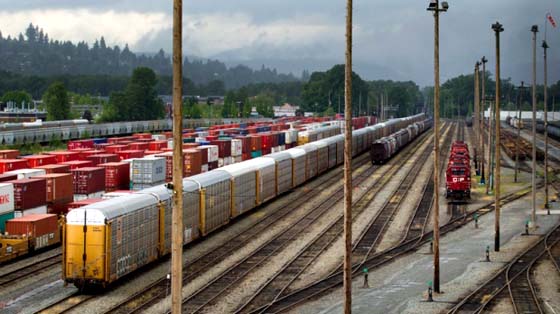BUILDING BLOCKS OF SUCCESS

The Canadian Pacific flat yard at Port Coquitlam east of Vancouver - 23 May 2012 Darryl Dyck.
Looking out the window of the Agincourt Yard traffic control tower, Trainmaster Drew Duquette isn't nostalgic. With all the
change he's overseen this past year there isn't time for it.
"This yard's hump is one of the highest in North America," explains Drew. "We stopped using it last summer after some
changes. After some trial and error, we're flat-switching now and the yard is in great shape, working at a high capacity and cycling
quicker than ever before." The result of the transition has been improved service, employee productivity, and profitability. In
Agincourt (just east of Toronto) and other yards, new technology, volume, and a shift in traffic type from individual boxcars and
containers to large blocks have necessitated change.
A FASTER FUTURE
Senior Vice-President of Canadian Operations Guido De Ciccio confirms that the shift from hump-switching to flat-switching, combined
with the implementation of a block scheduling strategy, has the potential to not only make individual yards more efficient, but to make
CP's national network more reliable. "A year ago, CP was the smallest of the six Class 1 railroads in North America, yet we
maintained hump yards in Calgary, Winnipeg, Toronto, St. Paul, and Bensenville. As part of our new vision, the benefits of
flat-switching versus hump-switching is setting us up to maximize the potential of our blocking strategy. "These are positive steps
for Canadian Pacific," says Guido. "These changes increase efficiencies in our yards, reduce dwell time, and are allowing us
to focus on other areas for further improvement. All of these design changes are being undertaken to improve service."
"A large part of the operating vision focuses on blocking, how we group individual cars and build our trains," explains
Drew. "CP is designing trains into larger blocks now, which share a common destination. This trims the time it takes to receive and
classify cars, and eliminates the need to hump those cars, which takes a lot of time, money, and man-hours." Previously, when a
train would pull into Agincourt hauling 80 cars destined for yards all over North America, it would take as long as four hours to hump
those cars into blocks. "Today, the plan is to reduce the amount of switching on route, allowing us to achieve a maximum train
capacity. This means we must look at the individual cars within the block of traffic, and we need to be more strategic when we schedule
the trip plan, not simply the plan for the overall block," adds Drew. With this shift, that 80-car train arriving at Agincourt Yard
might have four blocks of cars with four destinations instead of every second car having a different destination.
HUMP VS. FLAT
When building blocks of traffic we will either use a hump-switch, which utilizes the gravity of a slope to quickly move individual
cars to various destinations, or a flat-switch, for times when a train arrives with pre-assembled blocks, enabling it to be quickly
reassembled and dispatched without humping. While hump yards with sufficient workload can be efficient for processing cars quickly,
they're also high-maintenance facilities, demanding a heavy volume to justify their cost. A single engine and crew do all the in-yard
flat-switching now (except for St. Paul Yard). The crew takes a certain number of cars from one of the yard tracks and moves them to a
track known as the "switching lead." Agincourt Yard Trainmaster Drew Duquette says, "If the trains are better classified
when they get here, we get a train with four blocks on it, instead of hundreds of feet of cars bound for different locations. Today,
we'll simply switch those solid blocks onto other trains and avoid hump-switching altogether." We have kept one hump yard open
though, our St. Paul, Minnesota, USA, yard. "When Hunter and I visited St. Paul," explains Guido, "we asked ourselves why
we were doing business this way here. With more than 1,000 cars humped per day, the volume was nearer what it needs to be for a hump
yard to be profitable. So, we realized that maybe we didn't need to close it." They decided to up the humping speed from 1.25-1.50
mph to 2.50 mph. The result? A 23 percent increase in cars humped per day. "That volume increase justifies us keeping the St. Paul
hump open. Now we have the ability to move as many as 1,800 cars per day, something that simply wasn't going to work at the other
humps.
This Canadian Pacific Magazine article is copyright 2013 by the Canadian
Pacific Railway and is reprinted here with their permission. All logos, and trademarks are the property of the Canadian Pacific
Railway Company.


Vancouver Island
British Columbia
Canada
|



